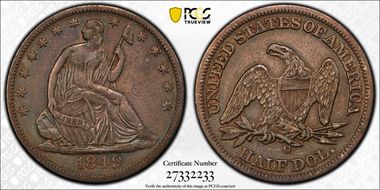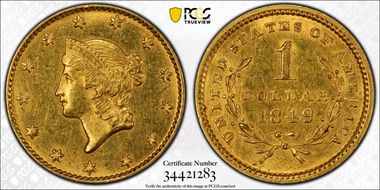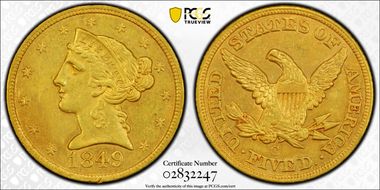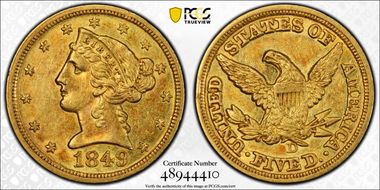Daniel Edward Knight (1849-1929), Samantha Ann Morris (1849-1889) 的钱币相册
The 1849 Half Dime has the second largest mintage of any Half Dime date from the 1840s. However, the date is split into three major varieties: 1849 Normal Date, 1849/8, and 1849/6. While the overdates take up some of the mintage, the remaining Normal Dates are still relatively common and are valued only slightly higher than the most common P-Mints. Most 1849 Half Dimes are struck well and show strong details, especially in the central areas of the dies.
The 1849-O Half Dollar boasts a hefty mintage of over 2.3 million coins. However, that did not translate into a large number of Mint State examples. Either no one thought they would turn out to be rare or the collectors were too far away to obtain examples before they entered circulation. Of the Mint State examples that exist today, most are in the MS63 to MS64 range. Gems are exceedingly rare and we know of no superb examples. Luster on the 1849-O Half Dollars goes from soft and frosty to bright and almost proof-like. Don't expect a sharp strike on this dare; invariably, most of the obverse stars will appear flat and weakly defined.
The first Gold Dollars debuted in 1849, the result of a large influx of gold from California. The first versions are of the Open Wreath variety, showing the tips of the wreath distant from the 1 of the denomination. Later in the year, the Closed Wreath variety became the design of choice and was used until the end of the Type I series in 1854. The 1849 Open Wreath design includes both the With L and the No L varieties (these refer to the designer's initial which appears, or does not, on the truncation of the bust). Apart from the single No L variety, researcher John Dannreuther has identified three different With L varieties. PCGS alone has certified well over 1,000 1849 Open Wreath Gold Dollars, allowing collectors to choose from large numbers of MS62 to MS64 examples. Even Gems are relatively common, but MS67 and better examples are exceedingly rare. For mind-blowing quality, there's always the PCGS MS69 -- one of the finest Gold Dollars of any date.
The 1849-C is the most available Charlotte half eagle produced prior to 1850. It is often compared to the 1848-C due to similar mintage but the 1849-C is more readily available, especially in higher grades. The 1849-C is among the more common half eagles from this mint. It is relatively easy to locate in Very Fine ad Extremely Fine grades and can be found in the lower About Uncirculated grades without a huge effort. It is scarce in the higher AU grades and rare in Uncirculated... STRIKE: This is among the best struck half eagles from this mint. As a result, the 1849-C is very popular with type collectors who are seeking a single, well-produced example of this denomination. The detail on the obverse is actually comparable to that seen on Philadelphia half eagles of this era. The hair detail is typically sharp with the exception of the curls below LIB in LIBERTY which range from soft to very soft. On most examples, the stars have full radial lines and the denticles are individually defined. The reverse is well detailed as well. The legs and claws of the eagle are usually full and the neck feather and shield are sharp. The only area that sometimes shows weakness is the tip of the eagle’s right wing.
The 1849-D half eagle is very similar in rarity to the 1848-D. Like the 1848-D, it is a coin whose true rarity (especially in high grades) has not yet been fully acknowledged. The 1849-D half eagle is usually found in Very Fine to Extremely Fine grades. It is sometimes seen in About Uncirculated-50 but it is quite rare in any About Uncirculated grade above this. In full Mint State, the 1849-D is an extremely rare coin. STRIKE: The 1849-D is one of the last half eagles from this mint which can be consistently found with an acceptable strike. Most have better overall definition on the obverse than on the reverse. The area on the obverse which is most likely to show weakness is the curls below IBER in LIBERTY. The rest of the detail is usually sharp, including the stars and denticles. The reverse is often somewhat weak on the tips of the wing, the lower part of the neck and the right leg and claw. SURFACES: A number are known which show mint-made areas of granularity. Most are heavily marked but it is possible to locate an 1849-D half eagles which is not covered with detracting abrasions. LUSTER: The luster tends to be frosty in texture. A few are known which are slightly reflective in the fields. COLORATION: Original, uncleaned pieces show coloration which ranges from medium green-gold to deep orange-gold. Most have been cleaned or dipped and no longer show original coloration. EYE APPEAL: Compared to some of the other Dahlonega half eagles of the 1840’s, the 1849-D shows above average eye appeal. There are a number of well struck, attractive examples in existence. PERSONAL OBSERVATIONS: The 1849-D half eagle is a reasonably common coin in most circulated grades but it is extremely rare in Uncirculated. As with the similarly dated quarter eagle, it may be overlooked due to the 1849-D gold dollar being fairly available in Uncirculated. DIE VARIETIES: Three die varieties are currently known. Variety 21-N: On obverse, the date is not as well centered as on the next variety and is positioned higher in relation to the neck. The reverse is the same as described for Variety 19-N, except that there is absolutely no trace of the mispunched mintmark. It is not known which of the two 1849-D half eagle varieties is rarer. Variety 22-L: On the obverse, the date is well centered in the space between the neck and the denticles. The reverse has a high mintmark that touches both the stem and the feather. The left edge of the mintmark is over the center of the right diagonal of the V in FIVE. Variety 22-N: This is a newly discovered variety that combines the obverse and reverse dies listed above. It appears to be very rare. This is a very rare date in all grades, more so than the D Mint coins from 1843 to 1847 and roughly comparable to the 1848-D and 1850-D. It is much more rare as a date than the 1851-D, 1852-D, 1853-D and 1854-D and it has actually had fewer auction appearances than some of the
























